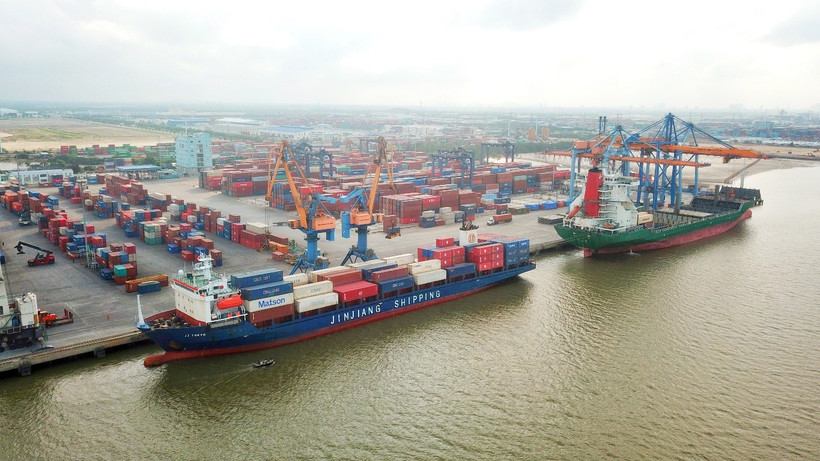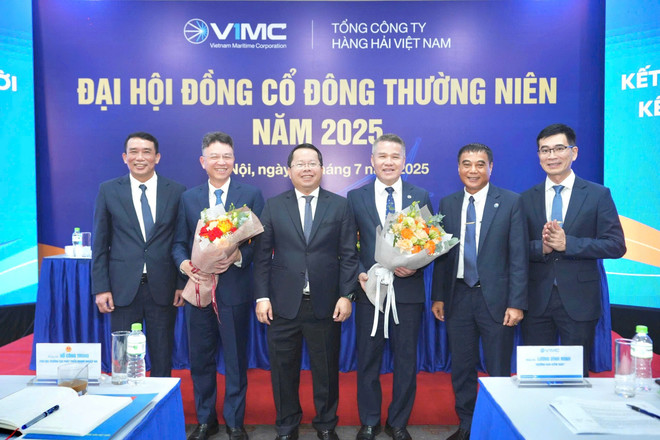VIMC invests heavily in deep-water and transit ports, expanding its fleet
VIMC will continue to focus resources on strategic infrastructure projects, especially the construction of deep-water ports, international transit ports, and the expansion of its fleet to enhance competitiveness.

(Photo: PV/Vietnam+)
Vietnam National Shipping Lines (VIMC) will invest in upgrading the seaport system, expanding the fleet, digital transformation, and promoting the logistics service chain to increase profits.
The above information was given at VIMC's 2025 Annual General Meeting of Shareholders on the morning of July 9.
According to Mr. Le Anh Son, Chairman of the Board of Directors of VIMC, the world situation is forecast to continue to develop complicatedly in the coming time. Shipping indexes have dropped sharply to their lowest level since June 2020 due to weakening demand and risks related to US trade policy. Many shipping lines have begun to resume service routes through the Red Sea.
In that context, VIMC will expand its business activities around its strengths such as container port operations, integrated logistics, bulk cargo transportation, agricultural products, iron and steel, etc. to create additional revenue and profit sources in addition to traditional business segments, with the goal of both maximizing the capacity of the existing port system and taking advantage of the fleet to increase transport output.
VIMC focuses on optimizing operational efficiency at key hubs such as wharves, port yards, fleets, etc. by improving operational productivity, shortening loading and unloading time, and ship turnaround time; cost management will be enhanced, especially fleet operating costs and container exploitation at the port, ensuring economical and efficient use of resources.
In addition, Mr. Son said that the Corporation will implement important transformation actions in 2025, focusing on digital transformation, process improvement and competitiveness enhancement. These actions will lay the foundation for VIMC to make a breakthrough in the next decade, playing a leading role in the maritime and logistics services sector of Vietnam.
In the coming period, VIMC will continue to focus resources on strategic infrastructure projects, especially the construction of deep-water ports, international transit ports and ICD systems in key economic zones.
The Corporation also invests in building new generation ships, high-tech ships, prioritizing the development of a modern container fleet to enhance VIMC's maritime transport capacity; building a focused, flexible, customer-oriented business model.
Regarding restructuring, this enterprise plans to promote the enterprise restructuring program with a focus on units that are operating inefficiently and have suffered prolonged losses.
Mr. Nguyen Canh Tinh was elected from the position of General Director to hold the position of Chairman of the Board of Directors, while Mr. Le Anh Son was elected from the position of Chairman of the Board of Directors to hold the position of General Director of VIMC.
 Board of Directors of Vietnam National Shipping Lines. (Photo: Viet Hung/Vietnam+)
Board of Directors of Vietnam National Shipping Lines. (Photo: Viet Hung/Vietnam+)Previously, according to VIMC's report, in 2024, VIMC still exceeded its targets in output, revenue and profit compared to the set plan.
Specifically, the parent company's output reached nearly 4 million tons. Total revenue reached VND3,157 billion and pre-tax profit reached VND1,353 billion.
Viet Hung
www.vietnamplus.vn
Contact information
sghp.ops@saigonport.vn
Phone number
028 3 8260 640
Fax
0283 943 2457
Address
D10C Road D3, Hiep Phuoc Commune, HCMC

